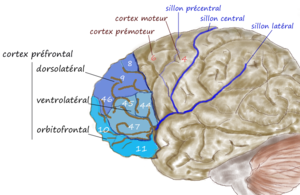Dorsolateral prefrontal cortex
| Dorsolateral Prefrontal Cortex | |
|---|---|

An illustration of brain's prefrontal region
|
|
| Details | |
| Identifiers | |
| Latin | Cortex praefrontalis dorsolateralis |
| NeuroLex ID | Dorsolateral prefrontal cortex |
|
Anatomical terms of neuroanatomy
[]
|
|
The dorsolateral prefrontal cortex (DLPFC or DL-PFC) is an area in the prefrontal cortex of the brain of humans and non-human primates. It is one of the most recently evolved parts of the human brain. It undergoes a prolonged period of maturation which lasts until adulthood. The DLPFC is not an anatomical structure, but rather a functional one. It lies in the middle frontal gyrus of humans (i.e., lateral part of Brodmann's area (BA) 9 and 46). In macaque monkeys, it is around the principal sulcus (i.e., in Brodmann's area 46). Other sources consider that DLPFC is attributed anatomically to BA 9 and 46 and BA 8, 9 and 10.
The DLPFC has connections with the orbitofrontal cortex, as well as the thalamus, parts of the basal ganglia (specifically, the dorsal caudate nucleus), the hippocampus, and primary and secondary association areas of neocortex (including posterior temporal, parietal, and occipital areas). The DLPFC is also the end point for the dorsal pathway (stream), which is concerned with how to interact with stimuli.
An important function of the DLPFC is the executive functions, such as working memory, cognitive flexibility, planning, inhibition, and abstract reasoning. However, the DLPFC is not exclusively responsible for the executive functions. All complex mental activity requires the additional cortical and subcortical circuits with which the DLPFC is connected. The DLPFC is also the highest cortical area that is involved in motor planning, organization and regulation.
As the DLPFC is composed of spatial selective neurons, it has a neural circuitry that encompasses the entire range of sub-functions necessary to carry out an integrated response, such as: sensory input, retention in short-term memory, and motor signaling. Historically, the DLPFC was defined by its connection to: the superior temporal cortex, the posterior parietal cortex, the anterior and posterior cingulate, the premotor cortex, theretrosplenial cortex, and the neocerebellum. These connections allow the DLPFC to regulate the activity of those regions, as well as to receive information from and be regulated by those regions.
...
Wikipedia
